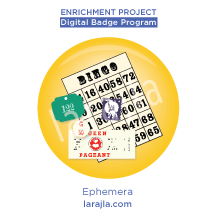Ephemera is any material that was originally designed to be discarded after use. It includes concert tickets, advertising trading cards, postcards, catalogs, greeting cards, pamphlets, matchbook covers and letters. Some people include old photos. Items that are not printed like watch parts and vintage fabric/ lace pieces can be thought of as ephemera. Ephemera is used in collages, mixed media and altered artwork.
Steps
1. Purchasing ephemera.
Ephemera is big business. From mixed media artists to scrapbookers, you can find ephemera available on CDs, as printed sheets or as digital images. Find a few companies who sell ephemera to see the variety that is available. You can also check out eBay for people selling originals.
2. Copyright.
The company that is selling ephemera may not have rights to the items. Manipulations done to it, which results in a new product, are protected. Compilations are also protected. If you purchase ephemera, make sure you are aware of how you are allowed to use, distribute and / or sell not only the ephemera itself but any items you create with the ephemera. If you own the ephemera, you can use it any way you wish as long as the copyright to the piece itself has expired.
3. Making a collection.
Starting a collection can be free or costly, depending on how you acquire pieces. Explore the “finding ephemera” steps to start and grow your collection. Sort your collection by date, type, colors or any way that works for you.
4. Inspiration.
Your ephemera collection can be used for inspiration when you’re not feeling particularly creative. Look at designs that work or don’t work. What is visually pleasing for you? What don’t you like? What do you like? Try to explain why you feel this way.
5. Crafting with ephemera.
Ephemera can be used with artistic trading cards, scrapbooks and mixed media projects . . . to name just a few. Check out how ephemera can be incorporated in crafts you like to do. Feel free to share your experiences.
6. Sharing your collection.
Thinking of sharing? You can trade items, sell them or create digital images to upload or e-mail to others. Find others to share with and provide files / copies they can use. This can be a swap group like swap-bot, one-on-one or with a group of like-minded collectors.
Finding ephemera
7. Your current resources — free resources.
You are constantly being bombarded with ephemera that you can repurpose (recycle) into art. See the “Items to Collect” supplement for possible items to collect and use. Add any ideas you have to the list and share with others.
8. Friends and family — free resources.
Many people save small mementos as reminders of their lives. Ask friends and family if they have small items they’d be willing to part with. Again, use supplement for reference.
9. Flickr — free resources.
Flickr membership is free. You may need to join groups to get shared images. Make sure you load the image and download the highest resolution you can. If you plan on printing it out, the greater resolution will give you a larger image before bitmapping makes it unreadable. Even if you don’t think you’re going to print it out, it is better to spend the time now to get a better resolution image than fight later with them.
After you’ve downloaded and sorted some files, experiment with making a PDF or JPG contact sheet. A contact sheet places small images with the filenames in a grid on a page. This will allow you to browse your images faster. A sample contact sheet can be found with the supplements for this badge program.
10. Library of Congress — free resources.
www.loc.gov/library/libarch-digital.html
The Library of Congress has a digital collection of Americana. Check out their items and see if anything appeals to you. You might even recognize a few pieces.
11. Flea market / garage sale / yard sale / auction — pay resources.
You can get ephemera from any of these places. The prices will vary depending on the quality, seller, etc. While it may cost, this is generally less costly than purchasing ephemera online. You will also have the physical pieces, so you can control the digital quality if you choose to digitize your items. Try digitizing by photographing or scanning your items. Clean up watermarks, scratches, and other non-original markings.
12. eBay — pay resources.
eBay and other online auctions not only tend to cost more than locally acquired ephemera, but you also have to pay shipping. You cannot see exactly what you are purchasing until it arrives at your door and you are dependent on the honesty of the seller. Explore online ephemera sellers.
13. Dover Publications — pay resources.
Dover Publications sells printed and digitized ephemera. If you are purchasing ephemera, their offerings are some of the most affordable and diverse. Dover does offer free weekly samples of their publications so you can get lower resolution versions. Review their offerings. You may notice that other companies use their images to resell as their own.
14. What else can you find?
What other resources can you find? Do you have local historians or a section in your local library that you can utilize? Do local museums provide samplings online or in their gift shops? Is there a local ephemera group that will share with you? Share what you find.
Supplements
Sites to Explore
- www.youthedesigner.com/2007/10/25/starting-a-free-ephemera-collection
- en.wikipedia.org/wiki/Ephemera
- www.ephemeranet.com/index.html
- www.ephemerasociety.org/index.html
- www.squidoo.com/victorianephemra
- justsomethingimade.com
- www.mixedmediaart.net/mixed-media-materials/vintage-ephemera
- www.swap-bot.com

Leave a Reply